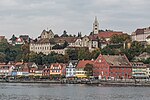Seefelder Aach
Baden-Württemberg river stubsRivers of Baden-WürttembergRivers of GermanyTributaries of Lake ConstanceTributaries of the Rhine

The Seefelder Aach is a river in the districts of Sigmaringen and Bodenseekreis, Tübingen region, southern Baden-Württemberg, Germany. It is approximately 55 kilometres long and flows into Lake Constance. It has a catchment area of 279 km² and is part of the Rhine river system. It starts as Salemer Aach and becomes the Seefelder Aach after the conjunction with the Deggenhauser Aach, further down from Salem. The upper part – near Aach-Linz – it is also colloquially called Linzer Aach or Hintere Aach.
Excerpt from the Wikipedia article Seefelder Aach (License: CC BY-SA 3.0, Authors, Images).Seefelder Aach
Seefelden, Uhldingen-Mühlhofen
Geographical coordinates (GPS) Address Phone number Website Nearby Places Show on map
Geographical coordinates (GPS)
| Latitude | Longitude |
|---|---|
| N 47.7331 ° | E 9.2264 ° |
Address
Camping Seeperle
Seefelden
88690 Uhldingen-Mühlhofen
Baden-Württemberg, Germany
Open on Google Maps









